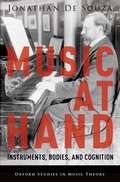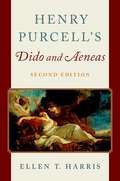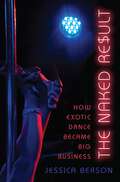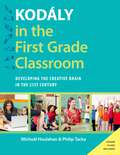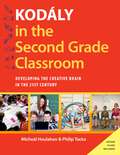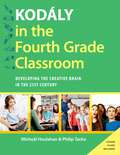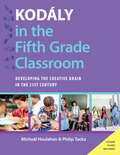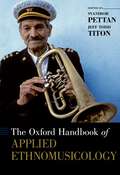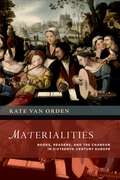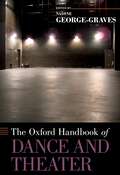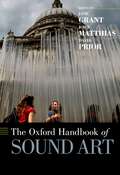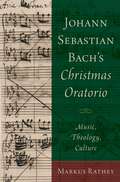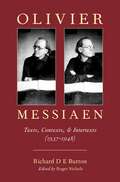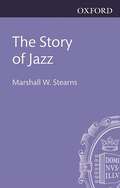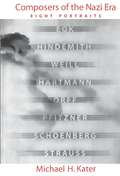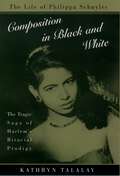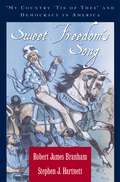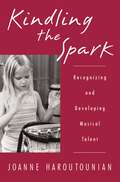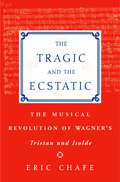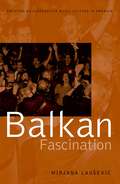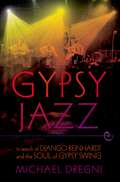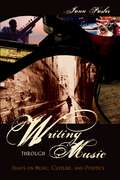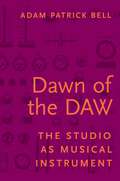- Table View
- List View
Music at Hand: Instruments, Bodies, and Cognition (Oxford Studies in Music Theory)
by Jonathan De SouzaFrom prehistoric bone flutes to pipe organs to digital synthesizers, instruments have been important to musical cultures around the world. Yet, how do instruments affect musical organization? And how might they influence players' bodies and minds? Music at Hand explores these questions with a distinctive blend of music theory, psychology, and philosophy. Practicing an instrument, of course, builds bodily habits and skills. But it also develops connections between auditory and motor regions in a player's brain. These multi-sensory links are grounded in particular instrumental interfaces. They reflect the ways that an instrument converts action into sound, and the ways that it coordinates physical and tonal space. Ultimately, these connections can shape listening, improvisation, or composition. This means that pianos, guitars, horns, and bells are not simply tools for making notes. Such technologies, as creative prostheses, also open up possibilities for musical action, perception, and cognition. Throughout the book, author Jonathan De Souza examines diverse musical case studies-from Beethoven to blues harmonica, from Bach to electronic music-introducing novel methods for the analysis of body-instrument interaction. A companion website supports these analytical discussions with audiovisual examples, including motion-capture videos and performances by the author. Written in lucid prose, Music at Hand offers substantive insights for music scholars, while remaining accessible to non-specialist readers. This wide-ranging book will engage music theorists and historians, ethnomusicologists, organologists, composers, and performers-but also psychologists, philosophers, media theorists, and anyone who is curious about how musical experience is embodied and conditioned by technology.
Music at Hand: Instruments, Bodies, and Cognition (Oxford Studies in Music Theory)
by Jonathan De SouzaFrom prehistoric bone flutes to pipe organs to digital synthesizers, instruments have been important to musical cultures around the world. Yet, how do instruments affect musical organization? And how might they influence players' bodies and minds? Music at Hand explores these questions with a distinctive blend of music theory, psychology, and philosophy. Practicing an instrument, of course, builds bodily habits and skills. But it also develops connections between auditory and motor regions in a player's brain. These multi-sensory links are grounded in particular instrumental interfaces. They reflect the ways that an instrument converts action into sound, and the ways that it coordinates physical and tonal space. Ultimately, these connections can shape listening, improvisation, or composition. This means that pianos, guitars, horns, and bells are not simply tools for making notes. Such technologies, as creative prostheses, also open up possibilities for musical action, perception, and cognition. Throughout the book, author Jonathan De Souza examines diverse musical case studies-from Beethoven to blues harmonica, from Bach to electronic music-introducing novel methods for the analysis of body-instrument interaction. A companion website supports these analytical discussions with audiovisual examples, including motion-capture videos and performances by the author. Written in lucid prose, Music at Hand offers substantive insights for music scholars, while remaining accessible to non-specialist readers. This wide-ranging book will engage music theorists and historians, ethnomusicologists, organologists, composers, and performers-but also psychologists, philosophers, media theorists, and anyone who is curious about how musical experience is embodied and conditioned by technology.
Henry Purcell's Dido and Aeneas
by Ellen T. HarrisPurcell's Dido and Aeneas stands as the greatest operatic achievement of seventeenth-century England, and yet, despite its global renown, it remains cloaked in mystery. The date and place of its first performance cannot be fixed with precision, and the absolute accuracy of the surviving scores, which date from almost 100 years after the work was written, cannot be assumed. In this thirtieth-anniversary new edition of her book, Ellen Harris closely examines the many theories that have been proposed for the opera's origin and chronology, considering the opera both as political allegory and as a positive exemplar for young women. Her study explores the work's historical position in the Restoration theater, revealing its roots in seventeenth-century English theatrical and musical traditions, and carefully evaluates the surviving sources for the various readings they offer-of line designations in the text (who sings what), the vocal ranges of the soloists, the use of dance and chorus, and overall layout. It goes on to provide substantive analysis of Purcell's musical declamation and use of ground bass. In tracing the performance history of Dido and Aeneas, Harris presents an in-depth examination of the adaptations made by the Academy of Ancient Music at the end of the eighteenth century based on the surviving manuscripts. She then follows the growing interest in the creation of an "authentic" version in the nineteenth and early twentieth centuries through published editions and performance reviews, and considers the opera as an important factor in the so-called English Musical Renaissance. To a significant degree, the continuing fascination with Purcell's Dido and Aeneas rests on its apparent mutability, and Harris shows this has been inherent in the opera effectively from its origin.
The Naked Result: How Exotic Dance Became Big Business
by Jessica BersonWe have grown accustomed to corporate influence in retail outlets, restaurants, and even higher education-but what happens when corporations take over desire? The Naked Result: How Exotic Dance Became Big Business explores the changing world of striptease, tracing its path from the unruly underground to brightly lit, branded 'gentlemen's clubs.' Drawing on her own experience as an exotic dancer, Jessica Berson examines the ways that striptease embodies conflicting notions of race, class, and female sexuality, and how the exotic dance industry deploys these differences to codify and commodify our erotic imagination. Chain clubs, fitness programs, and music videos are moving exotic dance into the mainstream, stripping its historical potential to embody and express subversive desires-erotic and otherwise-and generate resistant modes of female erotic subjectivity. Through case studies including Boston's Combat Zone in the 1970s-80s, the development of lap dancing in London in the 1990s, and the triumph of corporate striptease in post-Giuliani New York City in the last decade,The Naked Result reveals an industry that increasingly eradicates individuality and agency in order to increase profits. Ultimately, The Naked Result argues that corporatization has cheerfully smothered the diversity of desire and expression for both dancers and customers, repackaging the most mysterious human emotions into easily branded experiences no more personal or powerful than those to be found in any themed restaurant or coffee mega-chain.
KODALY IN THE FIRST GRADE CLASSR KTHS C: Developing the Creative Brain in the 21st Century (Kodaly Today Handbook Series)
by Philip Tacka Micheal HoulahanSince the mid-twentieth century, Zoltán Kodály's child-developmental philosophy for teaching music has had significant positive impact on music education around the world, and is now at the core of music teaching in the United States and other English speaking countries. The Kodály Today handbook series is the first comprehensive system to update and apply the Kodály concepts to teaching music in elementary school classrooms. Kodály in the First Grade Classroom provides teachers with a step-by-step road map for developing children's performance, creative movement, and literacy skills in an organic and thoughtful manner. Through six years of field-testing with music kindergarten teachers in the United States, Great Britain, and Hungary (the home country of Zoltán Kodály), authors Micheál Houlahan and Philip Tacka have developed a methodology specifically for 21st century classrooms. Houlahan and Tacka use the latest research findings in cognition and perception to create a system not only appropriate for the developmental stages of first grade students but also one which integrates vertically between elementary music classes. The methods outlined in this volume encourage greater musical ability and creativity in children by teaching them to sing, move, play instruments, and develop music literacy skills. In addition, Kodály in the First Grade Classroom promotes critical thinking, problem solving, and collaboration skills. Although the book uses the Kodály philosophy, its methodology has also been tested by teachers certified in Orff and Dalcroze, and has proven an essential guide for teachers no matter what their personal philosophy and specific training might be. Numerous children's songs are incorporated into Kodály in the First Grade Classroom, as well as over 35 detailed lesson plans that demonstrate how music and literacy curriculum goals are transformed into tangible musical objectives. Scholarly yet practical and accessible, this volume is sure to be an essential guide for kindergarten and early childhood music teachers everywhere.
Kodály in the Second Grade Classroom: Developing the Creative Brain in the 21st Century (Kodaly Today Handbook Series)
by Philip Tacka Micheal HoulahanSince the mid-twentieth century, Zoltán Kodály's child-developmental philosophy for teaching music has had significant positive impact on music education around the world, and is now at the core of music teaching in the United States and other English speaking countries. The Kodály Today handbook series is the first comprehensive system to update and apply the Kodály concepts to teaching music in elementary school classrooms. Kodály in the Second Grade Classroom provides teachers with a step-by-step road map for developing children's performance, creative movement, and literacy skills in an organic and thoughtful manner. Through six years of field-testing with music kindergarten teachers in the United States, Great Britain, and Hungary (the home country of Zoltán Kodály), authors Micheál Houlahan and Philip Tacka have developed a methodology specifically for 21st century classrooms. Houlahan and Tacka use the latest research findings in cognition and perception to create a system not only appropriate for the developmental stages of second grade students but also one which integrates vertically between elementary music classes. The methods outlined in this volume encourage greater musical ability and creativity in children by teaching them to sing, move, play instruments, and develop music literacy skills. In addition, Kodály in the Second Grade Classroom promotes critical thinking, problem solving, and collaboration skills. Although the book uses the Kodály philosophy, its methodology has also been tested by teachers certified in Orff and Dalcroze, and has proven an essential guide for teachers no matter what their personal philosophy and specific training might be. Numerous children's songs are incorporated into Kodály in the Second Grade Classroom, as well as over 35 detailed lesson plans that demonstrate how music and literacy curriculum goals are transformed into tangible musical objectives. Scholarly yet practical and accessible, this volume is sure to be an essential guide for kindergarten and early childhood music teachers everywhere.
KODALY IN THE FOURTH GRADE CLASSR KTHS C: Developing the Creative Brain in the 21st Century (Kodaly Today Handbook Series)
by Philip Tacka Micheal HoulahanSince the mid-twentieth century, Zoltán Kodály's child-developmental philosophy for teaching music has had significant positive impact on music education around the world, and is now at the core of music teaching in the United States and other English speaking countries. The Kodály Today handbook series is the first comprehensive system to update and apply the Kodály concepts to teaching music in elementary school classrooms. Kodály in the Fourth Grade Classroom provides teachers with a step-by-step road map for developing children's performance, creative movement, and literacy skills in an organic and thoughtful manner. Through six years of field-testing with music teachers in the United States, Great Britain, and Hungary (the home country of Zoltán Kodály), authors Micheál Houlahan and Philip Tacka have developed a methodology specifically for 21st century classrooms. Houlahan and Tacka use the latest research findings in cognition and perception to create a system not only appropriate for the developmental stages of fourth graders but also one which integrates vertically between elementary music classes. The methods outlined in this volume encourage greater musical ability and creativity in children by teaching them to sing, move, play instruments, and develop music literacy skills. In addition, Kodály in the Fourth Grade Classroom promotes critical thinking, problem solving, and collaboration skills. Although the book uses the Kodály philosophy, its methodology has also been tested by teachers certified in Orff and Dalcroze, and has proven an essential guide for teachers no matter what their personal philosophy and specific training might be. Over 100 children's books are incorporated into Kodály in the Fourth Grade Classroom, as well as 35 detailed lesson plans that demonstrate how music and literacy curriculum goals are transformed into tangible musical objectives. Scholarly yet practical and accessible, this volume is sure to be an essential guide for elementary music teachers everywhere.
KODALY IN THE FIFTH GRADE KTHS C: Developing the Creative Brain in the 21st Century (Kodaly Today Handbook Series)
by Philip Tacka Micheal HoulahanSince the mid-twentieth century, Zoltán Kodály's child-developmental philosophy for teaching music has had significant positive impact on music education around the world, and is now at the core of music teaching in the United States and other English speaking countries. The Kodály Today handbook series is the first comprehensive system to update and apply the Kodály concepts to teaching music in elementary school classrooms. Kodály in the Fifth Grade Classroom provides teachers with a step-by-step road map for developing children's performance, creative movement, and literacy skills in an organic and thoughtful manner. Through six years of field-testing with music kindergarten teachers in the United States, Great Britain, and Hungary (the home country of Zoltán Kodály), authors Micheál Houlahan and Philip Tacka have developed a methodology specifically for 21st century classrooms. Houlahan and Tacka use the latest research findings in cognition and perception to create a system not only appropriate for the developmental stages of first grade students but also one which integrates vertically between elementary music classes. The methods outlined in this volume encourage greater musical ability and creativity in children by teaching them to sing, move, play instruments, and develop music literacy skills. In addition, Kodály in the Fifth Grade Classroom promotes critical thinking, problem solving, and collaboration skills. Although the book uses the Kodály philosophy, its methodology has also been tested by teachers certified in Orff and Dalcroze, and has proven an essential guide for teachers no matter what their personal philosophy and specific training might be. Numerous children's songs are incorporated into Kodály in the Fifth Grade Classroom, as well as over 35 detailed lesson plans that demonstrate how music and literacy curriculum goals are transformed into tangible musical objectives. Scholarly yet practical and accessible, this volume is sure to be an essential guide for kindergarten and early childhood music teachers everywhere.
The Oxford Handbook of Applied Ethnomusicology (Oxford Handbooks)
by Svanibor Pettan and Jeff Todd TitonApplied studies scholarship has triggered a not-so-quiet revolution in the discipline of ethnomusicology. The current generation of applied ethnomusicologists has moved toward participatory action research, involving themselves in musical communities and working directly on their behalf. The essays in The Oxford Handbook of Applied Ethnomusicology, edited by Svanibor Pettan and Jeff Todd Titon, theorize applied ethnomusicology, offer histories, and detail practical examples with the goal of stimulating further development in the field. The essays in the book, all newly commissioned for the volume, reflect scholarship and data gleaned from eleven countries by over twenty contributors. Themes and locations of the research discussed encompass all world continents. The authors present case studies encompassing multiple places; other that discuss circumstances within a geopolitical unit, either near or far. Many of the authors consider marginalized peoples and communities; others argue for participatory action research. All are united in their interest in overarching themes such as conflict, education, archives, and the status of indigenous peoples and immigrants. A volume that at once defines its field, advances it, and even acts as a large-scale applied ethnomusicology project in the way it connects ideas and methodology, The Oxford Handbook of Applied Ethnomusicology is a seminal contribution to the study of ethnomusicology, theoretical and applied.
MATERIALITIES NCHM C: Books, Readers, and the Chanson in Sixteenth-Century Europe (New Cultural History of Music)
by Kate van OrdenEphemeral, fragile, often left unbound, sixteenth-century songbooks led fleeting lives in the pockets of singers and on the music desks of instrumentalists. Constantly in action, they were forever being used up, replaced, or abandoned as ways of reading changed. As such they document the acts of early musicians and the practices of everyday life at the unseen margins of elite society. Materialities is a cultural history of song on the page. It addresses a series of central questions concerning the audiences for written music by concentrating on the first genre to be commercialized by music printers: the French chanson. Scholars have long stressed that chansons represent the most broadly disseminated polyphony of the sixteenth century, but Materialities is the first book to account for the cultural reach of the chanson across a considerable cross-section of European society. Musicologist Kate van Orden brings extensive primary research and new analytical models to bear in this remarkable history of songbooks, music literacy, and social transformation during the first century of music printing. By tracking chansons into private libraries and schoolrooms and putting chansonniers into dialogue with catechisms, civility manuals, and chapbooks, Materialities charts the social distribution of songbooks, the gradual moralization of song, and the ways children learned their letters and notes. Its fresh conclusions revise several common assumptions about the value early moderns attributed to printed music, the levels of literacy required to perform polyphony, and the way musicians did or did not "read" their songbooks. With musical perspectives that can invigorate studies of print culture and the history of reading, Materialities is an essential guide for musicologists working with original sources and historians of the book interested in the vocal performances that operated alongside print.
The Oxford Handbook of Dance and Theater (Oxford Handbooks)
by Nadine George-GravesThe Oxford Handbook of Dance and Theater collects a critical mass of border-crossing scholarship on the intersections of dance and theatre. Taking corporeality as an idea that unites the work of dance and theater scholars and artists, and embodiment as a negotiation of power dynamics with important stakes, these essays focus on the politics and poetics of the moving body in performance both on and off stage. Contemporary stage performances have sparked global interest in new experiments between dance and theater, and this volume situates this interest in its historical context by extensively investigating other such moments: from pagan mimes of late antiquity to early modern archives to Bolshevik Russia to post-Sandinista Nicaragua to Chinese opera on the international stage, to contemporary flash mobs and television dance contests. Ideologically, the essays investigate critical race theory, affect theory, cognitive science, historiography, dance dramaturgy, spatiality, gender, somatics, ritual, and biopolitics among other modes of inquiry. In terms of aesthetics, they examine many genres such as musical theater, contemporary dance, improvisation, experimental theater, television, African total theater, modern dance, new Indian dance theater aesthetics, philanthroproductions, Butoh, carnival, equestrian performance, tanztheater, Korean Talchum, Nazi Movement Choirs, Lindy Hop, Bomba, Caroline Masques, political demonstrations, and Hip Hop. The volume includes innovative essays from both young and seasoned scholars and scholar/practitioners who are working at the cutting edges of their fields. The handbook brings together essays that offer new insight into well-studied areas, challenge current knowledge, attend to neglected practices or moments in time, and that identify emergent themes. The overall result is a better understanding of the roles of dance and theater in the performative production of meaning.
The Oxford Handbook of Sound Art (Oxford Handbooks)
Sound art has long been resistant to its own definition. Emerging from a liminal space between movements of thought and practice in the twentieth century, sound art has often been described in terms of the things that it is understood to have left behind: a space between music, fine art, and performance. The Oxford Handbook of Sound Art surveys the practices, politics, and emerging frameworks of thought that now define this previously amorphous area of study. Throughout the Handbook, artists and thinkers explore the uses of sound in contemporary arts practice. Imbued with global perspectives, chapters are organized in six overarching themes of Space, Time, Things, Fabric, Senses and Relationality. Each theme represents a key area of development in the visual arts and music during the second half of the twentieth century from which sound art emerged. By offering a set of thematic frameworks through which to understand these themes, this Handbook situates constellations of disparate thought and practice into recognized centers of activity.
The Oxford Handbook of Sound Art (Oxford Handbooks)
by Jane Grant, John Matthias, David PriorSound art has long been resistant to its own definition. Emerging from a liminal space between movements of thought and practice in the twentieth century, sound art has often been described in terms of the things that it is understood to have left behind: a space between music, fine art, and performance. The Oxford Handbook of Sound Art surveys the practices, politics, and emerging frameworks of thought that now define this previously amorphous area of study. Throughout the Handbook, artists and thinkers explore the uses of sound in contemporary arts practice. Imbued with global perspectives, chapters are organized in six overarching themes of Space, Time, Things, Fabric, Senses and Relationality. Each theme represents a key area of development in the visual arts and music during the second half of the twentieth century from which sound art emerged. By offering a set of thematic frameworks through which to understand these themes, this Handbook situates constellations of disparate thought and practice into recognized centers of activity.
Johann Sebastian Bach's Christmas Oratorio: Music, Theology, Culture
by Markus RatheyIn the last decades of the 17th century, the feast of Christmas in Lutheran Germany underwent a major transformation when theologians and local governments waged an early modern "war on Christmas," discouraging riotous pageants and carnivalesque rituals in favor of more personal and internalized expressions of piety. Christmas rituals, such as the "Heilig Christ" plays and the rocking of the child (Kindelwiegen) were abolished, and Christian devotion focused increasingly on the metaphor of a birth of Christ in the human heart. John Sebastian Bach's Christmas Oratorio, composed in 1734, both reflects this new piety and conveys the composer's experience living through this tumult during his own childhood and early career. Markus Rathey's book is the first thorough study of this popular masterpiece in English. While giving a comprehensive overview of the Christmas Oratorio as a whole, the book focuses on two themes in particular: the cultural and theological understanding of Christmas in Bach's time and the compositional process that led Bach from the earliest concepts to the completed piece. The cultural and religious context of the oratorio provides the backdrop for Rathey's detailed analysis of the composition, in which he explores Bach's compositional practices, for example, his reuse and parodies of movements that had originally been composed for secular cantatas. The book analyzes Bach's original score and sheds new light on the way Bach wrote the piece, how he shaped musical themes, and how he revised his initial ideas into the final composition.
Olivier Messiaen: Texts, Contexts, and Intertexts (1937--1948)
by Richard D BurtonThe 20th century French composer Olivier Messiaen was a devout Roman Catholic and notably claimed that his music was an expression of his faith. Unsurprisingly, many performers and listeners consider Messiaen's strong religiosity central to their appreciation of the composer's music. Music scholars have devoted much energy to exploring how Messiaen's music was an extension of his religious beliefs. Yet, these works tend to discuss Messiaen's Catholicism solely in terms of personal religious identity and ignore the composer's broader connections to the cultural landscape of Roman Catholicism in France. In Olivier Messiaen: Texts, Contexts, and Intertexts (1937-1948) the late French literature scholar Richard Burton examines nine of Messiaen's works in the context of the broader French Catholic intellectual tradition. Drawing on an expansive knowledge of the Catholic literature and the surrealist tradition, Burton reveals that Messiaen's middle-period compositions are filled with intertextual references to the Bible and other theological writings, which Messiaen, given his reputation for falsifying facts, may have gone to great lengths to obscure. As a Catholic, Messiaen is presented as somewhat removed from the ethos of his time and place, taking no part in the social side of Catholicism that found expression in the P?tainist litany of 'Patrie, Famille, Travail'. Rather, Messiaen regarded himself as having a 'vertical' relationship with God, which could make him seem unworldly and even uncaring. With insights into the artistic careers of Messiaen's notable contemporaries and historical perspectives on the breakdown of French politics during World War II, Burton creates a vivid picture of the previously unexamined spiritual and philosophical inspirations behind Messiaen's pivotal mid-century compositions.
The Story of Jazz
by Marshall W. StearnsThe effect of jazz upon American culture and the American character has been all-pervasive. This superlative history is the first and the most renowned systematic outline of the evolution of this unique American musical phenomenon. Stearns begins with the joining of the African Negro's musical heritage with European forms and the birth of jazz in New Orleans then follows its course through the era of swing and bop to the beginnings of rock in the 50s, vividly depicting the great innovators, and covering such technical elements as the music's form and structure.
Composers of the Nazi Era: Eight Portraits
by Michael H. KaterHow does creativity thrive in the face of fascism? How can a highly artistic individual function professionally in so threatening a climate? Composers of the Nazi Era is the final book in a critically acclaimed trilogy that includes Different Drummers (OUP 1992) and The Twisted Muse (OUP 1997), which won the Wallace K. Ferguson Prize of the Canadian Historical Association. Here, historian Michael H. Kater provides a detailed study of the often interrelated careers of eight prominent German composers who lived and worked amid the dictatorship of the Third Reich, or were driven into exile by it: Werner Egk, Paul Hindemith, Kurt Weill, Karl Amadeus Hartmann, Carl Orff, Hans Pfitzner, Arnold Schoenberg, and Richard Strauss. Kater weighs issues of accommodation and resistance to ask whether these artists corrupted themselves in the service of a criminal regime--and if so, whether this may be discerned from their music. After chapters discussing the circumstances of each composer individually, Kater concludes with an analysis of the composers' different responses to the Nazi regime and an overview of the sociopolitical background against which they functioned. The final chapter also extends the discussion beyond the end of World War II to examine how the composers reacted to the new and fragile democracy in Germany.
Composition in Black and White: The Life of Philippa Schuyler
by Kathryn TalalayGeorge Schuyler, a renowned and controversial black journalist of the Harlem Renaissance, and Josephine Cogdell, a blond, blue-eyed Texas heiress and granddaughter of slave owners, believed that intermarriage would "invigorate" the races, thereby producing extraordinary offspring. Their daughter, Philippa Duke Schuyler, became the embodiment of this theory, and they hoped she would prove that interracial children represented the final solution to America's race problems. Able to read and write at the age of two and a half, a pianist at four, and a composer by five, Philippa was often compared to Mozart. During the 1930s and 40s she graced the pages of Time and Look magazines, the New York Herald Tribune, and The New Yorker. Philippa grew up under the adoring and inquisitive eyes of an entire nation and soon became the role model and inspiration for a generation of African-American children. But as an adult she mysteriously dropped out of sight, leaving America to wonder what had happened to the "little Harlem genius." Suffering the double sting of racism and gender bias, Philippa had been rejected by the elite classical music milieu in the United States and forced to find an audience abroad, where she flourished as a world-class performer and composer. She traveled throughout South America, Europe, Africa, and Asia performing for kings, queens, and presidents. By then Philippa had added a second career as an author and foreign correspondent reporting on events around the globe--from Albert Schweitzer's leper colony in Lamberéné to the turbulent Asian theater of the 1960s. She would give a command performance for Queen Elisabeth of Belgium one day, and hide from the Viet Cong among the ancient graves of the Annam kings another. But behind the scrim of adventure, glamour, and intrigue was an American outcast, a woman constantly searching for home and self. "I am a beauty--but I'm half colored...so I'm always destined to be an outsider," she wrote in her diary. Philippa tried to define herself through love affairs, but found only disappointment and scandal. In a last attempt to reclaim an identity, she began to "pass" as Caucasian. Adopting an Iberian-American heritage, she reinvented herself as Felipa Monterro, an ultra-right conservative who wrote and lectured for the John Birch Society. Her experiment failed, as had her parents' dream of smashing America's racial barriers. But at the age of thirty five, Philippa finally began to embark on a racial catharsis: She was just beginning to find herself when on May 9, 1967, while on an unauthorized mission of mercy, her life was cut short in a helicopter crash over the waters of war-torn Vietnam. The first authorized biography of Philippa Schuyler, Composition in Black and White draws on previously unpublished letters and diaries to reveal an extraordinary and complex personality. Extensive research and personal interviews from around the world make this book not only the definitive chronicle of Schuyler's restless and haunting life, but also a vivid history of the tumultuous times she lived through, from the Great Depression, through the Civil Rights movement, to the Vietnam war. Talalay has created a highly perceptive and provocative portrait of a fascinating woman.
Sweet Freedom's Song: "My Country 'Tis of Thee" and Democracy in America
by the late Robert James Branham Stephen J. HartnettAlthough it isn't the official national anthem, America may be the most important and interesting patriotic song in our national repertoire. Sweet Freedom's Song: "My Country 'Tis of Thee" and Democracy in America is a celebration and critical exploration of the complicated musical, cultural and political roles played by the song America over the past 250 years. Popularly known as My Country 'Tis of Thee and as God Save the King/Queen before that this tune has a history as rich as the country it extols. In Sweet Freedom's Song, Robert Branham and Stephen Hartnett chronicle this song's many incarnations over the centuries. Colonial Americans, Southern slaveowners, abolitionists, temperance campaigners and labor leaders, among others, appropriated and adapted the tune to create anthems for their own struggles. Because the song has been invoked by nearly every grassroots movement in American history, the story of America offers important insights on the story of democracy in the United States. An examination of America as a historical artifact and cultural text, Sweet Freedoms Song is a reflection of the rebellious spirit of Americans throughout our nations history. The late Robert James Branham and his collaborator, Stephen Hartnett, have produced a thoroughly-researched, delightfully written book that will appeal to scholars and patriots of all stripes.
Kindling the Spark: Recognizing and Developing Musical Talent
by Joanne HaroutounianGathering perspectives of musical talent from the psychological, musical, and educational fields, Kindling the Spark is the only single sourcebook that defines musical talent and provides practical strategies for identifying and nurturing it. Joanne Haroutounian uses her experience as teacher, researcher, and parent to clarify central issues concerning talent recognition and development in a way that will easily appeal to a wide audience. The book describes the different stages of development in musical training, including guidelines for finding a suitable teacher at different levels, social and psychological aspects that impact musical training, and research on talent development by ages and stages from infancy and preschool years through the teen years. An important feature of the book are "sparkler exercises" designed to provoke observable talent behavior in home, school, and studio settings. The book also includes an Appendix of Resources which lists books, media, organizations, and specialized schools that offer additional information on musical talent, identification, and development. For music educators in both public school and private studio settings--as well as for parents and their musically inclined children--Kindling the Spark provides an invaluable summary of the research on talent and a wealth of resources for developing it.
The Tragic and the Ecstatic: The Musical Revolution of Wagner's Tristan and Isolde
by ChafeDuring the years preceding the composition of Tristan and Isolde, Wagner's aesthetics underwent a momentous turnaround, principally as a result of his discovery of Schopenhauer. Many of Schopenhauer's ideas, especially those regarding music's metaphysical significance, resonated with patterns of thought that had long been central to Wagner's aesthetics, and Wagner described the entry of Schopenhauer into his life as "a gift from heaven." Chafe argues that Wagner's Tristan and Isolde is a musical and dramatic exposition of metaphysical ideas inspired by Schopenhauer. The first part of the book covers the philosophical and literary underpinnings of the story, exploring Schopenhauer's metaphysics and Gottfried van Strassburg's Tristan poem. Chafe then turns to the events in the opera, providing tonal and harmonic analyses that reinforce his interpretation of the drama. Chafe acts as an expert guide, interpreting and illustrating most important moments for his reader. Ultimately, Chafe creates a critical account of Tristan, in which the drama is shown to develop through the music.
Balkan Fascination: Creating an Alternative Music Culture in America (American Musicspheres)
by Mirjana LausevicDivi Zheni identifies itself as a Bulgarian women's chorus and band, but it is located in Boston and none of its members come from Bulgaria. Zlatne Uste is one of the most popular purveyors of Balkan music in America, yet the name of the band is grammatically incorrect. The members of Sviraci hail from western Massachusetts, upstate New York, and southern Vermont, but play tamburica music on traditional instruments. Curiously, thousands of Americans not only participate in traditional music and dance from the Balkans, but in fact structure their social practices around it without having any other ties to the region. In Balkan Fascination, ethnomusicologist Mirjana Lausevic, a native of the Balkans, investigates this remarkable phenomenon to explore why so many Americans actively participate in specific Balkan cultural practices to which they have no familial or ethnic connection. Going beyond traditional interpretations, she challenges the notion that participation in Balkan culture in North America is merely a specialized offshoot of the 1960s American folk music scene. Instead, her exploration of the relationship between the stark sounds and lively dances of the Balkan region and the Americans who love them reveals that Balkan dance and music has much deeper roots in America's ideas about itself, its place in the world, and the place of the world's cultures in the American melting pot. Examining sources that span more than a century and come from both sides of the Atlantic, Lausevic shows that an affinity group's debt to historical movements and ideas, though largely unknown to its members, is vital in understanding how and why people make particular music and dance choices that substantially change their lives.
Gypsy Jazz: In Search of Django Reinhardt and the Soul of Gypsy Swing
by Michael DregniOf all the styles of jazz to emerge in the twentieth century, none is more passionate, more exhilaratingly up-tempo, or more steeped in an outsider tradition than Gypsy Jazz. And there is no one more qualified to write about Gypsy Jazz than Michael Dregni, author of the acclaimed biography, Django. A vagabond music, Gypsy Jazz is played today in French Gypsy bars, Romany encampments, on religious pilgrimages--and increasingly on the world's greatest concert stages. Yet its story has never been told, in part because much of its history is undocumented, either in written form or often even in recorded music. Beginning with Django Reinhardt, whose dazzling Gypsy Jazz became the toast of 1930s Paris in the heady days of Josephine Baker, Picasso, and Hemingway, Dregni follows the music as it courses through caravans on the edge of Paris, where today's young French Gypsies learn Gypsy Jazz as a rite of passage, along the Gypsy pilgrimage route to Les Saintes-Maries-de-la-Mer where the Romany play around their campfires, and finally to the new era of international Gypsy stars such as Bireli Lagrene, Boulou Ferre, Dorado Schmitt, and Django's own grandchildren, David Reinhardt and Dallas Baumgartner. Interspersed with Dregni's vivid narrative are the words of the musicians themselves, many of whom have never been interviewed for the American press before, as they describe what the music means to them. Gypsy Jazz also includes a chapter devoted entirely to American Gypsy musicians who remain largely unknown outside their hidden community. Blending travelogue, detective story, and personal narrative, Gypsy Jazz is music history at its best, capturing the history and culture of this elusive music--and the soul that makes it swing.
Writing through Music: Essays on Music, Culture, and Politics
by Jann PaslerDrawing on a passion for music, a remarkably diverse interdisciplinary toolbox, and a gift for accessible language that speaks equally to scholars and the general public, Jann Pasler invites us to read as she writes "through" music, unveiling the forces that affect our sonic encounters. In an extraordinary collection of historical and critical essays, some appearing for the first time in English, Pasler deconstructs the social, moral, and political preoccupations lurking behind aesthetic taste. Arguing that learning from musical experience is vital to our understanding of past, present, and future, Pasler's work trenchantly reasserts the role of music as a crucial contributor to important public debates about who we can be as individuals, communities, and nations. The author's wide-ranging and perceptive approaches to musical biography and history challenge us to rethink our assumptions about important cultural and philosophical issues including national identity and postmodern musical hybridity, material culture, the economics of power, and the relationship between classical and popular music. Her work uncovers the self-fashioning of modernists such as Vincent d'Indy, Augusta Holmès, Jean Cocteau, and John Cage, and addresses categories such as race, gender, and class in the early 20th century in ways that resonate with experiences today. She also explores how music uses time and constructs narrative. Pasler's innovative and influential methodological approaches, such as her notion of "question-spaces," open up the complex cultural and political networks in which music participates. This provides us with the reasons and tools to engage with music in fresh and exciting ways. In these thoughtful essays, music--whether beautiful or cacophonous, reassuring or seemingly incomprehensible--comes alive as a bearer of ideas and practices that offers deep insights into how we negotiate the world. Jann Pasler's Writing through Music brilliantly demonstrates how music can be a critical lens to focus the contemporary critical, cultural, historical, and social issues of our time.
Dawn of the DAW: The Studio as Musical Instrument
by Adam Patrick BellDawn ot the DAW tells the story of how the dividing line between the traditional roles of musicians and recording studio personnel (producers, recording engineers, mixing engineers, technicians, etc.) has eroded throughout the latter half of the twentieth century to the present. Whereas those equally adept in music and technology such as Raymond Scott and Les Paul were exceptions to their eras, the millennial music maker is ensconced in a world in which the symbiosis of music and technology is commonplace. As audio production skills such as recording, editing, and mixing are increasingly co-opted by musicians teaching themselves in their do-it-yourself (DIY) recording studios, conventions of how music production is taught and practiced are remixed to reflect this reality. Dawn of the DAW first examines DIY recording practices within the context of recording history from the late nineteenth century to the present. Second, Dawn of the DAW discusses the concept of "the studio as musical instrument" and the role of the producer, detailing how these constructs have evolved throughout the history of recorded music in tandem. Third, Dawn of the DAW details current practices of DIY recording--how recording technologies are incorporated into music making, and how they are learned by DIY studio users in the musically--chic borough of Brooklyn. Finally, Dawn of the DAW examines the broader trends heard throughout, summarizing the different models of learning and approaches to music making. Dawn of the DAW concludes by discussing the ramifications of these new directions for the field of music education.
